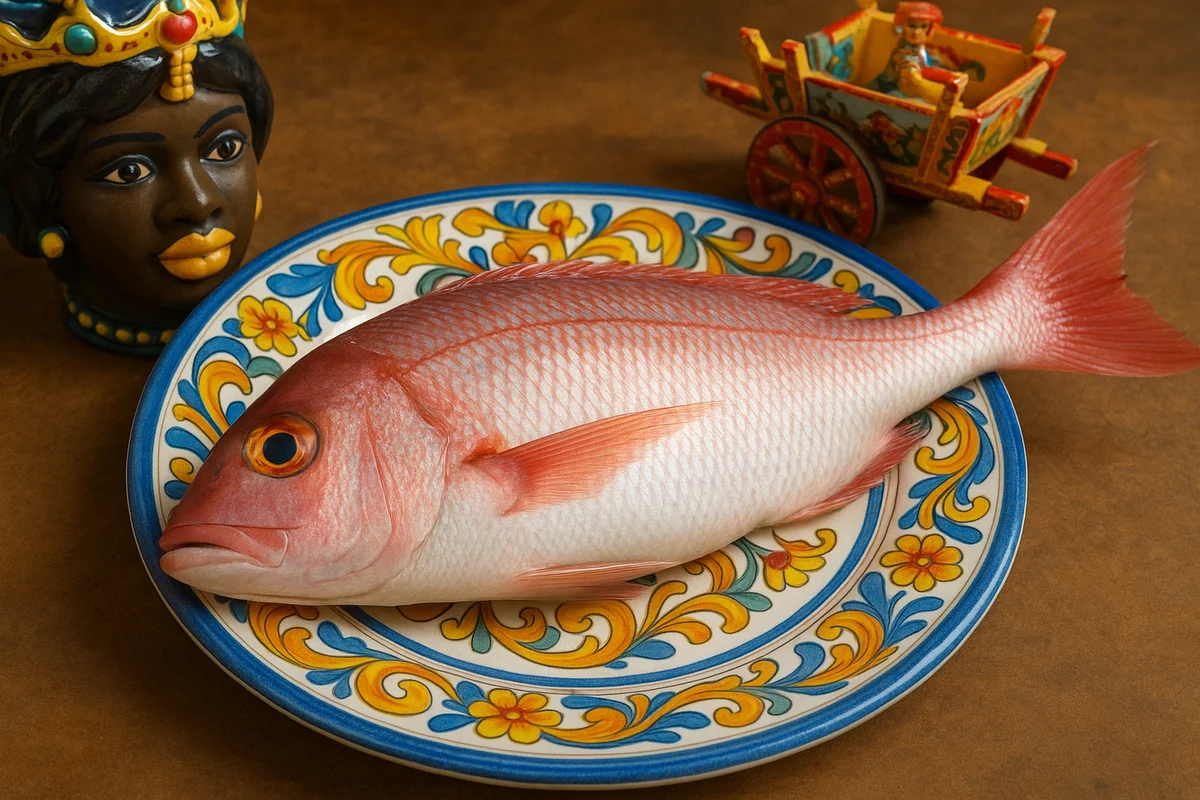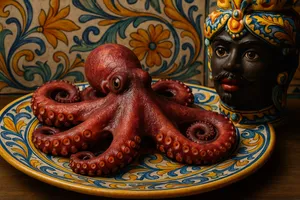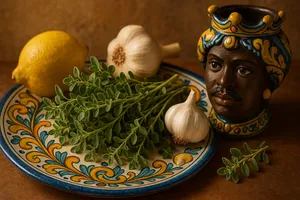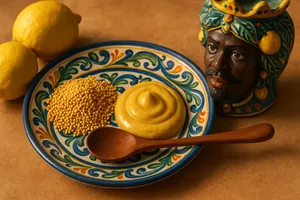Overview
Dentex is a prized sea fish belonging to the Sparidae family, highly appreciated in Sicilian cuisine for its delicate, fine-flavoured white flesh. This fish, which can reach considerable sizes, inhabits rocky seabeds and seagrass meadows of Sicilian waters, living either in schools or alone depending on age and species. Its name derives from the characteristic robust canine-like teeth, particularly noticeable in adult specimens.
In Sicilian gastronomy, dentex holds a place of honour among the most esteemed fish, featured in both simple preparations that highlight the purity of its flesh and elaborate recipes of the island’s maritime tradition. Its versatility in the kitchen and the excellence of its meat make it ideal for refined dishes representing the best of Sicily’s seafood heritage.
Characteristics
Dentex has an oval, laterally compressed body with an elegant, streamlined shape. The head is large with a balanced profile and a wide mouth equipped with strong canine teeth, from which the name derives. The colour varies by species: common dentex shows a pink-silver body with bluish reflections on the back, while the gibbous dentex has more reddish tones.
The flesh is white, firm and compact, maintaining its texture even after cooking. The flavour is delicate and slightly sweet, without overly intense marine notes. The meat flakes into regular segments and contains few bones, a characteristic much appreciated by consumers. Fresh dentex has a pleasant, clean sea smell, never ammonia-like.
Sizes vary according to species and age: from young specimens of 500 g–1 kg to adult fish of 5–10 kg or more. The skin is covered with relatively large scales that are easy to remove.
Varieties
Common dentex (Dentex dentex)
The most widespread and appreciated Mediterranean species, pink-silver with bluish tones on the back. It can reach up to 1 metre in length. This is Sicily’s quintessential dentex, renowned for its extraordinary flesh.
Gibbous dentex (Dentex gibbosus)
More intensely pink-red, with a stockier body. Adult specimens develop a characteristic hump on the forehead. Its flesh is equally prized but slightly firmer.
Large-eye dentex (Dentex macrophthalmus)
Easily recognised by its very large eyes. Generally smaller than other species. Its flesh is delicate and highly appreciated, though less well-known commercially.
Fishing and seasonality
In Sicilian waters, dentex is fished year-round, but the best seasons are spring and autumn when it approaches the coastline. Fishing is carried out mainly with nets, longlines and handlines. The most prized specimens are those caught with lines or longlines, which ensure better flesh quality.
Dentex fishing requires deep knowledge of seabeds and fish behaviour. Sicilian fishermen know where to find dentex depending on the season, depth and seabed type. Large specimens are increasingly rare due to overfishing.
Farmed dentex is increasingly common and available all year. While of good quality, it does not reach the flavour finesse of wild-caught fish.
Culinary uses
Dentex is prepared in many ways in Sicilian cuisine, all enhancing its qualities.
Baked dentex
The classic preparation uses whole fish or steaks seasoned with olive oil, lemon, garlic, parsley, cherry tomatoes and olives, then baked until golden. The result is an elegant, fragrant dish that highlights the fish’s delicate flavour.
Dentex “acqua pazza”
A traditional maritime recipe in which the fish is cooked in a light broth of tomato, garlic, chilli, parsley and white wine. “Acqua pazza” refers to the simple yet flavourful broth created during cooking.
Grilled dentex
Steaks or whole fish are marinated with olive oil, lemon, garlic and oregano, then grilled. Quick cooking keeps the flesh juicy and adds a light smoky aroma. It is often served with Sicilian salmoriglio.
Dentex baked in foil
The fish is wrapped in parchment or foil with vegetables, herbs and olive oil, then baked. This method keeps the flesh extremely tender and aromatic, concentrating all flavours.
Salt-crusted dentex
The whole fish is encased in coarse salt and baked. This traditional method preserves moisture and enhances flavour. The salt crust is dramatically broken open before serving.
Dentex carpaccio
With ultra-fresh fish, a raw carpaccio is prepared, thinly sliced and seasoned with olive oil, lemon, salt and pepper. A modern, elegant preparation that showcases the fish’s quality.
Fried dentex
Steaks or fillets are lightly floured and fried until golden. The flesh stays tender inside and crisp outside. Served with lemon and salt.
Preparation
Fresh dentex must be scaled, gutted and thoroughly washed. The scales are relatively large and easy to remove with a scaler or the back of a knife, working from tail to head. After gutting, the interior must be cleaned well, removing all residues and the dark membrane along the backbone.
To obtain steaks, cut the cleaned fish into slices 2–3 cm thick. For fillets, make an incision along the backbone and gently separate the meat from the bones, then remove any remaining pin bones with tweezers.
The skin may be left on or removed depending on the recipe. For baking or grilling, the skin helps keep the fish intact. For carpaccio or delicate preparations, it is usually removed.
Before cooking, a few diagonal cuts on the sides of a whole fish help even cooking and allow aromas to penetrate.
Cooking
Dentex requires careful cooking to avoid drying out the delicate flesh. In the oven, it cooks at 180–200°C for about 20–30 minutes for a 1–1.5 kg fish, and 35–45 minutes for larger ones. Steaks require 12–15 minutes.
On the grill, 2 cm steaks cook 3–4 minutes per side over medium-high heat. Whole fish requires 8–10 minutes per side, depending on size. For “acqua pazza”, allow 15–20 minutes for a 1 kg fish.
The fish is done when the flesh flakes easily from the bone and appears opaque. The ideal internal temperature is 60–63°C. Overcooking should be avoided, as dentex flesh can dry out quickly.
For carpaccio, the fish must be extremely fresh and frozen beforehand to eliminate parasites. It should be sliced very thinly with a sharp knife or a slicer.
Storage
Fresh dentex keeps in the refrigerator for 1–2 days in the coldest part, well cleaned, dried and wrapped in plastic wrap. It is best consumed as soon as possible to enjoy its delicacy.
It freezes very well: cleaned, dried, portioned if necessary, wrapped in plastic and placed in freezer bags. It keeps for 2–3 months. Thaw slowly in the refrigerator, never at room temperature.
Cooked dentex keeps for 1–2 days in the refrigerator in an airtight container. It can be used cold in seafood salads or gently reheated.
Buying tips
Fresh dentex should have clear, bright, convex eyes, never sunken or cloudy. The gills must be bright red or pink, moist and odour-free. The skin should be shiny and vibrant, with well-defined colours.
The flesh must be firm and elastic: when pressed, it should spring back without leaving a mark. The smell should be clean and fresh, never ammonia-like. The belly must not be swollen or soft.
Medium-sized fish (1–2 kg) are generally preferred for tender flesh. Always check provenance: dentex caught in Sicilian waters, when available, is preferable to farmed fish for flavour and texture.
The characteristic teeth should be visible and intact. Scales should adhere well to the skin, not lifted or missing.
Nutritional properties
Dentex is a semi-fat fish: 100 g provide about 100–120 calories. It is rich in high-quality protein (18–20 g per 100 g) and contains moderate fat (3–5 g per 100 g), mainly omega-3 fatty acids.
It is a good source of B vitamins (especially B12 and B6) and vitamin D. It contains important minerals such as phosphorus, potassium, magnesium, selenium and iodine. It has moderate sodium and cholesterol levels.
Its flesh is very digestible and suitable for everyone, including children, the elderly and people on low-fat diets. Omega-3 fatty acids contribute to cardiovascular health by reducing LDL cholesterol and triglycerides.
Dentex also provides essential amino acids important for growth and muscle maintenance.
Curiosities
The name “dentex” derives from Latin “dentex”, meaning “toothed”, referring to the fish’s robust canine-like teeth used to catch and grip prey, mainly smaller fish and cephalopods.
In Sicilian waters, fishermen recognise dentex by the characteristic strong “strike” it gives when biting, a sharp, powerful pull due to its strength. A sailors’ saying goes: “U dinnici muzzica comu un cani” (Dentex bites like a dog), referring to its sharp teeth.
In Greek mythology, dentex was considered sacred to Aphrodite. Legend says it accompanied the goddess, born from sea foam, as she travelled toward Cyprus.
In Trapani and the Egadi Islands, an ancient tradition of trolling for dentex exists, where lures are slowly dragged along rocky seabeds. Fishermen pass down secret spots and techniques through generations.
During tuna harvest season in Sicilian tuna traps, dentex were often caught alongside tuna and considered a prized “bonus” by fishermen due to their excellent flesh.
An old Sicilian proverb says: “Dinnici d’aprili, oru di Sicilia” (April dentex, Sicily’s gold), referring to the spring period when this fish reaches peak quality and its flesh is particularly prized.











